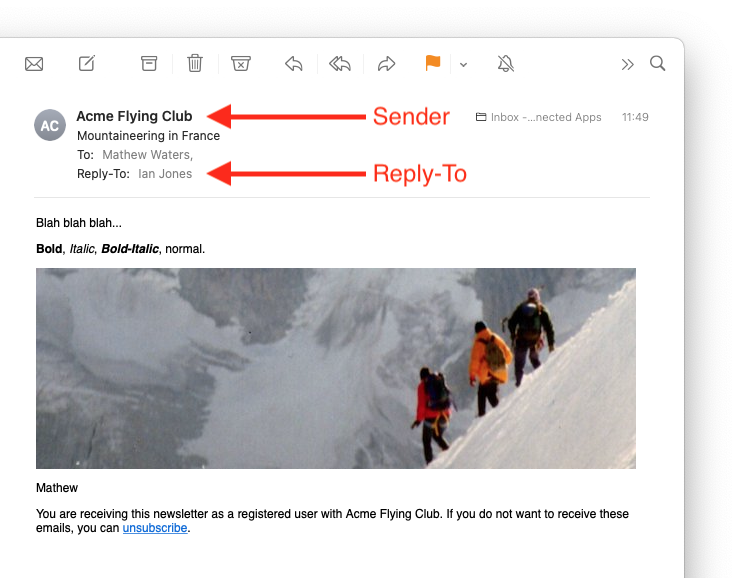The platform provides a system which you can use to keep in touch with your customers. The system was designed to send newsletters, operational and safety messages.
You create a message from the Messages tab. Once done, you decide the group(s) of people to receive it.
Why send newsletters?
A regular newsletter keeps people in touch with what is happening at the school. You may find the number of bookings increases as people are reminded to fly, especially if they have "dropped off the radar" and need a nudge to bring them back! As an example, the newsletter could contain things like:
- Any changes to club rules.
- Information about existing and new aircraft.
- New instructors.
- Recent GST passes or first solos.
- Related aviation news.
- Organised trips.
Note: Only Office staff can create messages.
To create a new message or to view previous messages (including work in progress), click the Messages tab.
The messages page displays a list of draft, queued and sent messages. If you want to work on a message you have not yet sent, you will find it listed as a draft.
To create a new message, click the button + New message. The following fields should be set:
- Subject. This is the subject line of the email.
- Body. The body text of your message. You can use the formatting buttons at the top of the edit box to choose text styles, insert images and links. When adding images, make sure the image is already formatted to 650 pixels wide. This size works well in email.
Scheduling
You can write a message ahead of time, and you don't have to write it from beginning to end: you can save your progress and come back to it later. The status column shows whether the message has been sent: it becomes "queued" and later "sent" when it is sent. The message is not published online, it is only visible to office staff in the system.
Note: Messages and any attached files are stored for twelve months and automatically deleted.
If you want to leave the message as work in progress and finish it later, you can find it again from the Messages tab as described already. To make changes to the message, click the link to the message followed by its Settings tab. To delete a message, click its Delete tab.
How do I send a test email first?
When the message is ready, we recommend sending a test email first to check it looks okay.
To do this, click the button marked + Send message shown above the content tabs. On the next screen, choose Send a test message and fill in your email address.
Click Send to send the message to this single address. The message remains unpublished and is only sent to the address you specify. You can view the email on your device or computer to check it looks good before sending to your members.
How do I send the message?
Choose Send to ... and choose the groups you want the newsletter to be sent to. For example, you might want to target the message toward current students or members.
You can schedule the message to start sending at a specific date and time. The system defaults the time for you and avoids sending outside normal office hours.
Once you're ready, click Send and the message is queued for delivery to all users who have one of the roles selected. Delivery starts shortly after the time you choose and continues until all emails have been sent. A new tab labelled Sent to appears to show who it was sent to.
In what format are the emails sent?
Emails are encoded as HTML, which allows you to include images, styled text etc. There is also a plain text version of the email, which is included for email programs that do not support HTML mail (or have this feature disabled).

Can people see each other's addresses?
No.
Each email is sent individually to the recipient with their address in the "To" field.
Who is the sender?
All emails are sent from a mailbox that does not receive incoming mail ("no-reply" at your Flight School Booking subdomain). All the emails are digitally signed to improve chance of successful delivery. (We use DKIM and SPF records for this).
Where do replies go?
You can choose whether replies to your message will be to your school address or to your own.
When the message is sent, the "Reply-To" header is set. Most email programs respect the reply-to header, meaning if anyone relies, their email will use your address for the recipient, and you will receive replies to the email address specified in your account settings.
Very few email programs ignore the Reply-To header, but if someone replies to the no-reply address, they will receive a failed delivery message to let them know.
Can people unsubscribe?
People with no specific role (the "everyone else" group) plus lapsed students and lapsed members can unsubscribe from any message. But for your current members and students, delivery depends on the type of message. Operational and safety messages are mandatory and will be delivered regardless of whether the user has unsubscribed from newsletters. Newsletters on the other hand are opt-out, and your users can unsubscribe.
Each newsletter contains a unique token which a recipient can click on to unsubscribe instantly. They do not need to log in first. The link is designed to allow them to do this with the minimum of effort and should reduce the chance of people flagging your newsletter as spam.
If a customer unsubscribes by mistake or later changes their mind, they re-subscribe from the Settings tab in their account page.
Customer's wishes should be respected and once someone has unsubscribed, they should not be re-subscribed without asking their permission. It is best to leave the notification settings to end users to manage themselves.